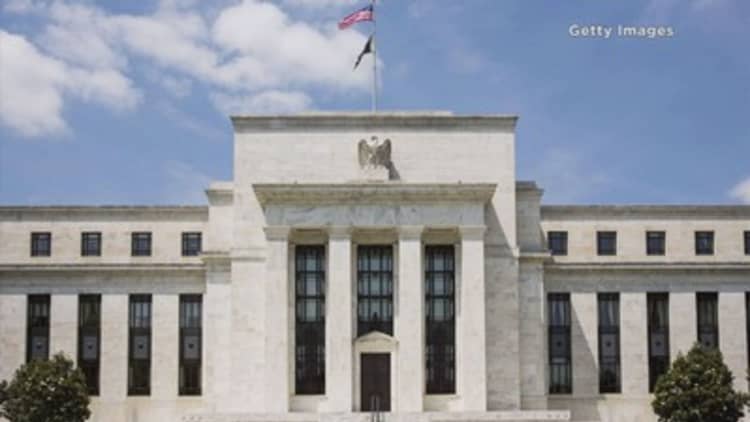
Consider the Federal Reserve the Starship Enterprise of monetary policy: It went where no central bank had gone before, and now must plot the journey home.
The Fed already has begun one leg of the trip, as it has started raising interest rates from financial crisis-era lows. Now, it is preparing to embark on what could be the more perilous part — shrinking the $4.5 trillion of bonds it holds on its so-called balance sheet.
In an effort to jump-start the economy out of the financial crisis and the Great Recession, the Fed instituted three rounds of bond buying aimed at getting the financial markets going again and generating what officials call a "wealth effect" that would spread through the economy.
While it may sound like just arcane monetary talk, the stakes are high for both investors and consumers.
Get it right and the Fed will have pulled off what its critics thought impossible, namely embarking on unprecedented intervention in the markets with little consequence.
Get it wrong and the fallout could be dramatic, including a sharp rise in interest rates and tumult in the stock and bond markets.
The Fed on Wednesday is expected to provide more clues about when the operation will begin. In the obtuse world of Fed-speak, central bank watchers are looking for whether the official post-meeting statement changes the language from balance-sheet reduction expected before the end of the year to "relatively soon."
How it works
The Fed's balance sheet in total now runs $4.53 trillion, nearly all of which is either Treasurys or mortgage-backed securities. Of the total, $3.7 trillion came during three rounds of buying that began in response to the Great Recession of 2007-09. The program, known as "quantitative easing" or, more colloquially, "money printing," was aimed at injecting money into the economy and encouraging risk-taking following the devastation of the financial crisis.
The Fed bought Treasurys, now totaling $2.46 trillion, and mortgage-backed securities — loans packaged together as bonds now valued at $1.78 trillion — and they will be the focus of the balance-sheet operation.
Those bonds carry various maturity dates. When the bonds reach maturity, current policy entails reinvesting the proceeds. That helps keep demand in the market for government bonds and holds rates low.
Under the current plan, the Fed will set caps on how much of the proceeds will be allowed to run off each month and reinvest the rest. The caps will raise in increments until they reach $50 billion a month, with $30 billion coming from Treasurys and $20 billion in MBS.
How long the process will last is unclear at this point. Goldman Sachs economists said they expect the balance sheet will come down to $2.6 trillion to $3 trillion in a process that likely would run until November 2021.
What could go wrong
Both the stock and bond markets have come to depend on the Fed's programs — both the low interest rates and the balance sheet expansion — in the post-crisis years. Stocks, as measured by the , have surged more than 250 percent since the recession lows, while interest rates have remained low across the spectrum.
Any fiddling with a $4.5 trillion batch of bonds, then, could have major consequences if it's not done the right way.
Fed Chair Janet Yellen has insisted the process will have minimal impacts — "like watching paint dry" is her preferred metaphor. So far the market seems to agree, with Goldman projecting that the ultimate impact of the program will add 0.65 percentage points to the 10-year Treasury yield from the beginning until 2021.
But Fed critics have worried for years that the central bank's reluctance to unwind crisis-era policies long after the crisis passed poses substantial dangers. The day is coming, then, when that will be put to the test.
"I have a bridge to sell you if you think a rate hike cycle combined with a shrinking balance sheet will go smoothly," Peter Boockvar, chief market analyst at The Lindsey Group, said back when the Fed first began talking about the balance sheet operation publicly. "If the exit process ends up turning messy — defined as a recession and bear market in stocks — was all this easing worth it? Be bullish if you think both news stories will turn out just fine. Be very worried if they don't."
What else is at stake?
Either way the Fed works things, the process of shedding trillions of dollars in bonds will take a long time.
Greg McBride, chief financial analyst at Bankrate.com, sees the process ultimately lasting 15 or 20 years, with plenty of rests in between as the Fed goes back to asset purchases during economic downturns.
"When you look at the context of a slow-growth economy, productivity growth that is abysmally low — that all adds up to a Fed that's not going to be able to be aggressive with interest rates or downsizing the balance sheet," McBride said in an interview earlier in the year.
"Seeing slow progress on both of these fronts just brings us to the intersection of an inevitable economic slowdown at some point long before interest rates get to more normal levels and the balance sheet is reduced significantly in size," he added.
However, there's a rather significant intangible in play.
Yellen may be winding down her career, with many Fed watchers figuring that President Donald Trump will not reappoint her when her term expires early next year. That means the chair may focus at least in part on legacy-building in the coming months.
"Unless renominated, Chair Yellen will leave her seat in February 2018 having defined her legacy as the first central bank leader to have successfully lifted off of the zero lower-bound and to have begun the process of post-financial crisis normalization," economists at Morgan Stanley said in a note. "If all goes well, it will be a gift to her successor."
Watch: How big is the Fed's balance sheet?



